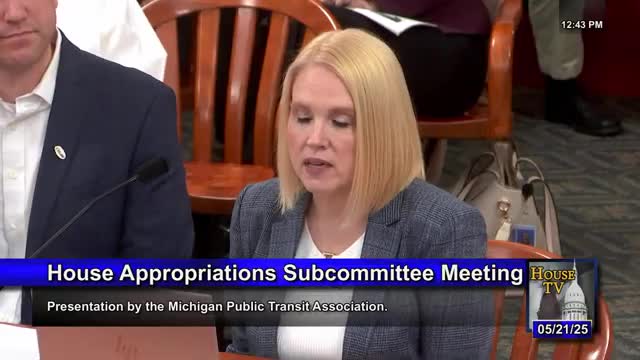Michigan transit agencies expand services amid rising ridership and funding challenges
May 21, 2025 | 2025 House Legislature MI, Michigan
This article was created by AI summarizing key points discussed. AI makes mistakes, so for full details and context, please refer to the video of the full meeting. Please report any errors so we can fix them. Report an error »

On May 21, 2025, the Michigan Legislature's Subcommittee on State and Local Transportation convened to discuss critical issues surrounding public transit in the state. The meeting highlighted the significant role of transit systems in Michigan, emphasizing their impact on the daily lives of residents and the economy.
Public transit in Michigan facilitates approximately 25,000 rides daily, translating to around 47 million trips annually. This extensive usage underscores the importance of transit services beyond just traditional bus systems. Various modes of transportation, including smaller vehicles and ferries, contribute to the overall transit network, which is essential for many Michiganders.
The meeting revealed that federal funding primarily supports capital costs, such as purchasing buses, while state and local funding, including millages and fares, are crucial for operational expenses. This funding structure is vital for transit agencies to expand services and meet community needs. For instance, agencies like Ross Common have successfully implemented medical transportation services for seniors, addressing a significant gap in rural areas.
Several success stories were shared, illustrating the growing demand for transit services. In Oakland County, a recent millage passed in 2022 led to a remarkable increase in ridership, with some agencies reporting growth rates of over 150%. This surge indicates a pent-up demand for transit options that were previously limited. Similarly, the Max transit system in the Holland-Zeeland area adapted its services based on community feedback, expanding hours to accommodate early shift workers, which has proven successful.
The meeting also highlighted the economic implications of transit services. Many users rely on public transportation to access jobs, education, and essential services, reinforcing the idea that transit is a critical economic driver. For example, the Ouachita Express Route in Ann Arbor has facilitated 84,000 rides since its launch, connecting residents to job opportunities that were previously inaccessible.
Despite these successes, challenges remain, particularly in staffing and funding. The Battle Creek area demonstrated a strong demand for on-demand services, with 150,000 requests made but only 33,000 trips provided. This gap illustrates the need for continued investment and support from local communities and state agencies.
In conclusion, the discussions during the meeting underscored the vital role of public transit in Michigan's economy and community well-being. As agencies continue to adapt and expand services, the collaboration between federal, state, and local funding sources will be crucial in meeting the growing demands of Michiganders. The anticipated next steps include further exploration of funding solutions and continued efforts to enhance transit accessibility across the state.
Public transit in Michigan facilitates approximately 25,000 rides daily, translating to around 47 million trips annually. This extensive usage underscores the importance of transit services beyond just traditional bus systems. Various modes of transportation, including smaller vehicles and ferries, contribute to the overall transit network, which is essential for many Michiganders.
The meeting revealed that federal funding primarily supports capital costs, such as purchasing buses, while state and local funding, including millages and fares, are crucial for operational expenses. This funding structure is vital for transit agencies to expand services and meet community needs. For instance, agencies like Ross Common have successfully implemented medical transportation services for seniors, addressing a significant gap in rural areas.
Several success stories were shared, illustrating the growing demand for transit services. In Oakland County, a recent millage passed in 2022 led to a remarkable increase in ridership, with some agencies reporting growth rates of over 150%. This surge indicates a pent-up demand for transit options that were previously limited. Similarly, the Max transit system in the Holland-Zeeland area adapted its services based on community feedback, expanding hours to accommodate early shift workers, which has proven successful.
The meeting also highlighted the economic implications of transit services. Many users rely on public transportation to access jobs, education, and essential services, reinforcing the idea that transit is a critical economic driver. For example, the Ouachita Express Route in Ann Arbor has facilitated 84,000 rides since its launch, connecting residents to job opportunities that were previously inaccessible.
Despite these successes, challenges remain, particularly in staffing and funding. The Battle Creek area demonstrated a strong demand for on-demand services, with 150,000 requests made but only 33,000 trips provided. This gap illustrates the need for continued investment and support from local communities and state agencies.
In conclusion, the discussions during the meeting underscored the vital role of public transit in Michigan's economy and community well-being. As agencies continue to adapt and expand services, the collaboration between federal, state, and local funding sources will be crucial in meeting the growing demands of Michiganders. The anticipated next steps include further exploration of funding solutions and continued efforts to enhance transit accessibility across the state.
View full meeting
This article is based on a recent meeting—watch the full video and explore the complete transcript for deeper insights into the discussion.
View full meeting
